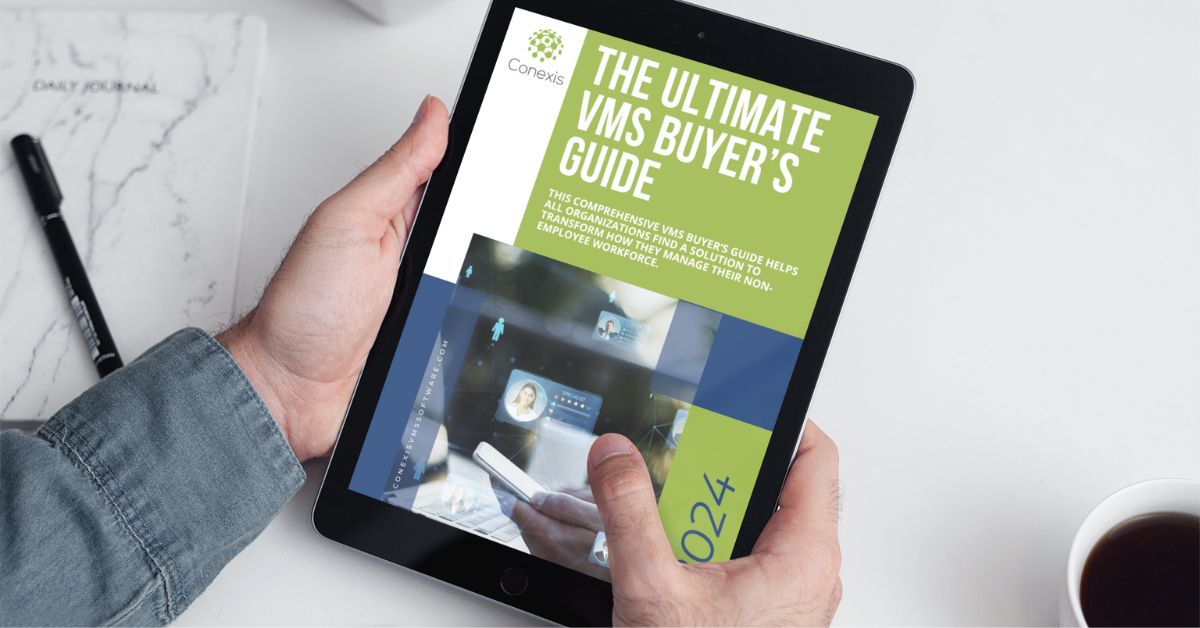Growing your Staffing Agency with a VMS: Your Complete Guide
Everything you need to know about how your Staffing Agency will benefit from a VMS
Learn More
How to Grow Your Staffing Agency With a Vendor Management System
One of the biggest opportunities in the staffing industry today is to leverage a Vendor Management System (VMS) to enhance your service offerings.
By integrating a VMS, your staffing agency can streamline operations, improve efficiency, and strengthen client relationships - positioning yourself as a strategic partner rather than just a service provider.
As demand for workforce automation and contingent workforce management continues to grow, adopting a VMS has become a key differentiator in the competitive staffing landscape.
Here's everything you need to know about the benefits of integrating a VMS in your staffing agency and how it will help grow your business and benefit your clients.
What is a VMS in Staffing?

Vendor Management Systems play a crucial role in the operations for staffing agencies.
A VMS provides a centralized platform for managing the entire vendor or supplier lifecycle, from initial onboarding to performance evaluation and payment processing. With a VMS in place, your staffing agency can efficiently track and manage vendor relationships, ensuring that you have access to the right talent at the right time.
Utilizing a VMS, your staffing agency can simplify its operations and boost efficiency. In addition, you can effortlessly handle vendor contracts, monitor performance indicators, and maintain adherence to industry standards. A VMS automates numerous manual tasks, including vendor onboarding, time tracking, and billing, allowing your agency's staff to dedicate more time to strategic projects that bring higher value to both your business and your clients.
Moreover, a VMS empowers your staffing agency to achieve enhanced insight into its contingent workforce and vendor performance. The right system delivers real-time data and analytics, enabling your agency to make informed decisions and refine its vendor management strategies.
When you know the significance of VMS for staffing agencies, you can fully leverage these systems to propel your business toward growth.
Benefits of a VMS

A vendor management system has capabilities and functionalities that result in many benefits for staffing agencies that implement one into their contingent workforce management strategy.
Through VMS implementation, businesses are able to ensure they have complete control and visibility over their contingent workforce, insights into staffing agency performance and standardized processes across the entire business. This all helps ensure significant ROI on the contingent workforce.
Here are just a few of the top business benefits a VMS can bring to your agency:
- The ability to obtain measurable results and advanced analytics into workforce requirements and staffing agency performance.
- Increased efficiency through the automation of processes.
- Reduced costs, through more strategic workforce decisions, better staffing agency partnerships and improved internal processes.
- Improved processes that ensure a company’s workforce remains compliant with employment laws and regulations.
- Contingent workforce management standardization across the entire business, ensuring hiring managers pay staffing agencies predetermined rates and follow standardized processes.
- A better vendor onboarding process for improved staffing agency partnerships.
Why Staffing Agencies Need a VMS
.png?width=600&height=314&name=Untitled%20design%20(1).png)
A major opportunity in the staffing industry today is to integrate a VMS into your service offerings.
By integrating a VMS into their service offering, staffing agencies can not only streamline operations for themselves but also position their agency as an indispensable partner to clients:
1. Helps You Become a Strategic Partner to Clients
In today's market, clients want strategic partners who understand their challenges and offer insights, not just staffing solutions. A VMS helps your staffing agency become this partner by providing visibility, insights, and efficient processes, strengthening client relationships and fostering loyalty. This approach is more strategic than just filling positions, especially as traditional methods like email and spreadsheets become outdated.
2. Opens New Markets and Opportunities
A VMS enables your agency to expand their services and access new markets by providing scalability and adaptability for diverse workforce needs. This helps your agency venture into new areas, diversify job categories, and manage larger clients, while also improving visibility into client volumes and securing more job opportunities through automation benefits.
3. Increase Client Stickiness
Retaining clients is essential in the staffing sector. By providing a VMS, your staffing agency becomes more embedded in your clients' operations, making it more challenging for them to switch to another provider. The enhanced services and efficient processes offered by a VMS foster a strong connection between your agency and your clients, decreasing turnover and strengthening long-term partnerships. Many VMS tools also provide white label solutions, ensuring clients have a seamless brand experience.
4. Reduce the Risk of Losing to Competitors
The staffing industry is fiercely competitive, and the threat of losing clients to competitors who offer a VMS, an MSP program, or clients directly engaging with a VMS is significant. Without providing a VMS, your agency might be susceptible to being surpassed by competitors who offer these solutions. Adopting a VMS strengthens your position, decreasing the chances that clients will be drawn to a competitor with these advanced services.
5. Enhanced Visibility and Control
A VMS offers clients full visibility and control over their contingent workforce, helping them make informed decisions, manage costs, ensure compliance, and improve performance. This transparency enhances your agency's reputation and protects against unfair client actions with documented evidence.
6. Streamlined Processes for Increased Efficiency
Managing contingent workers manually is prone to errors and time-consuming. A VMS automates key processes, improving efficiency and allowing your agency to handle more complex tasks, leading to faster client results and increased satisfaction. As clients digitize, a VMS is becoming essential.
7. Improved Compliance and Risk Management
Businesses face growing challenges in adhering to labor laws and regulations. A VMS helps streamline compliance and record-keeping, reducing non-compliance risks. It aids your staffing agency in guiding clients through complex regulations, enhancing their role in risk management. Key functions include tracking background checks, managing employment details, and overseeing compliance and expenditures.
8. Data-Driven Insights for Strategic Planning
A VMS provides analytical tools for deriving insights from workforce data, enabling better decision-making and strategic planning, which enhances the value of your agency and sets you apart from yourcompetitors. Reporting and analytics are now essential for clients.
How a VMS Will Grow Your Business
.png?width=600&height=314&name=Untitled%20design%20(2).png)
A VMS is more than just a tool for managing contingent labor; it’s a catalyst for stronger partnerships between your staffing agency and your clients. By unlocking the full potential of VMS data, reporting, and analytics, both parties can achieve greater efficiency, transparency, and strategic alignment. Here’s how:
1. Enhanced Visibility into Workforce Metrics
For Your Staffing Agency: A VMS centralizes all workforce data, offering agencies a holistic view of their performance across clients. This visibility enables agencies to track fill rates, time-to-fill metrics, and supplier performance in real-time. With this data, agencies can identify bottlenecks, optimize processes, and deliver measurable value to their clients.
For Your Clients: Clients benefit from access to transparent reporting on workforce spend, compliance metrics, and talent quality. This ensures alignment with their strategic goals while allowing them to make informed decisions on contingent workforce strategies.
2. Data-Driven Decision Making
For Your Staffing Agency: By leveraging predictive analytics within a VMS, agencies can forecast labor demand, identify high-performing job roles, and pinpoint trends in hiring patterns. This foresight allows agencies to proactively source talent and position themselves as indispensable partners.
For Your Clients: Clients can use VMS analytics to assess the cost-effectiveness of their contingent workforce programs. For example, comparing supplier rates, identifying cost outliers, and aligning workforce spending with budgetary goals empowers clients to optimize their ROI.
3. Customizable Dashboards for Real-Time Insights
For Your Staffing Agency: Customizable dashboards in a VMS provide agencies with the ability to segment data by region, industry, or job type. These insights help your agency refine its recruitment strategies, monitor compliance risks, and track candidate satisfaction levels - all tailored to your client needs.
For Your Clients: Clients gain real-time access to dashboards that highlight critical KPIs such as workforce utilization, compliance adherence, and spend under management. This fosters trust and strengthens the partnership by ensuring transparency and alignment.
4. Strengthened Compliance and Risk Management
For Your Staffing Agency: With robust reporting capabilities, your agency can monitor adherence to client-specific compliance requirements, labor laws, and certifications. A VMS ensures documentation is updated and easily accessible, reducing the risk of non-compliance penalties.
For Your Clients: Clients benefit from having a clear audit trail and the ability to track supplier adherence to their compliance standards. This mitigates legal and financial risks while ensuring workforce operations remain above board.
5. Increased Speed and Agility in Hiring
For Your Staffing Agency: Data from a VMS enables your agency to streamline candidate sourcing and placement processes. By analyzing past hiring trends, your agency can identify high-demand periods and prepare talent pools in advance, ensuring quicker response times.
For Your Clients: Clients can leverage hiring trend data to anticipate workforce needs and adjust strategies accordingly. Faster hiring processes mean reduced downtime and increased productivity.
6. Measurable ROI for Both Partners
For Your Staffing Agency: Your agency can use VMS analytics to quantify your impact on client success - whether it’s improving time-to-fill, reducing turnover rates, or ensuring cost savings. Demonstrating this value helps your agency retain clients and win new business.
For Your Clients: Clients can calculate ROI on their contingent workforce investments by evaluating the savings, efficiency gains, and productivity improvements delivered by their staffing agencies. This solidifies the business case for continued collaboration with your staffing agency.
Potential Challenges & Misconceptions for Staffing Agencies
.png?width=600&height=314&name=Untitled%20design%20(3).png)
Implementing a VMS When staffing agencies implement a vendor management system, they may encounter a few common challenges and misconceptions. Understanding these potential roadblocks can help ensure a smoother transition and better results.
1. Misconception: A VMS is Too Complicated to Implement
Many staffing agencies worry that adopting a VMS requires extensive technical expertise or a complete overhaul of their existing processes. While there is an adjustment period, most modern VMS platforms are designed to integrate with existing workflows seamlessly. With proper onboarding, training, and vendor support, your staffing agency can quickly adapt and start seeing benefits.
2. Challenge: Lack of Immediate Results
Agencies may expect instant improvements in efficiency and cost savings after implementing a VMS. However, optimizing workflows, training staff, and fully leveraging the system’s features take time. Setting realistic expectations and monitoring key performance indicators (KPIs) over time will help your agency measure long-term success.
3. Misconception: A VMS is One-Size-Fits-All
Some staffing agencies assume that all VMS platforms function the same way, but not every system is built for their specific industry or client base. Choosing a VMS that aligns with your agency’s business model, industry requirements, and compliance needs is essential for maximizing its value.
4. Challenge: Resistance to Change from Recruiters and Clients
Recruiters and clients may be hesitant to adopt a VMS due to unfamiliarity or concerns about added complexity. Your agency should communicate the benefits clearly, provide thorough training, and ensure that both internal teams and clients understand how the system improves efficiency, compliance, and reporting.
5. Misconception: A VMS is Too Expensive
While there may be upfront costs associated with implementing a VMS, the system often leads to cost savings by automating administrative tasks, improving compliance, and streamlining vendor relationships. Your agency should evaluate the long-term return on investment (ROI) rather than focusing solely on initial costs.
By addressing these challenges and misconceptions early in the implementation process, staffing agencies can ensure a successful transition to a VMS and maximize its benefits.
How Long Does it Take to Implement a VMS?
.png?width=600&height=314&name=Untitled%20design%20(4).png)
In the past, implementing a VMS was often a complex and time-consuming endeavor, requiring extensive planning, integration, and customization. The sheer scale and complexity of enterprise-level VMS deployments could easily stretch the implementation timeline to six months or more. However, the landscape has changed significantly in recent years, thanks to the advancements in VMS technology.
Today's VMS solutions are designed with a focus on rapid deployment and user-friendly configuration. Many providers now offer turnkey packages that can be set up and configured in weeks rather than months. These turnkey solutions often include pre-integrated software, cloud-based hosting, and streamlined processes, reducing the need for extensive on-site infrastructure and IT support.
While the longer implementation timeline may have been a valid concern in the past, the modern VMS landscape has evolved significantly. With turnkey solutions, modular design, and streamlined integration capabilities, VMS implementation can now be completed in a few short weeks!
Step-by-Step Implementation Guide for Staffing Agencies Adopting a VMS
.png?width=600&height=314&name=Untitled%20design%20(5).png)
Implementing a VMS can streamline operations, improve compliance, and enhance vendor relationships for your staffing agency. Follow this structured roadmap to ensure a smooth and successful transition.
Step 1: Assess Your Needs and Goals
-
Identify the key challenges your agency faces in vendor and workforce management.
-
Define the objectives you want to achieve with a VMS (e.g., cost reduction, efficiency, compliance, reporting).
-
Gather input from recruiters, account managers, and finance teams to understand their pain points.
Step 2: Research and Select the Right VMS
-
Evaluate different VMS platforms based on your agency's size, industry, and client needs.
-
Look for features such as automated billing, compliance tracking, real-time reporting, and integration with existing software (ATS, payroll, etc.).
-
Request demos and trial versions to compare usability and customization options.
-
Ensure the vendor provides strong customer support and training resources.
Step 3: Secure Buy-In from Stakeholders
-
Communicate the benefits of a VMS to recruiters, leadership, and clients.
-
Address concerns about implementation challenges and highlight long-term efficiency gains.
-
Involve key team members in the decision-making process to foster engagement.
Step 4: Plan the Implementation Timeline
-
Develop a phased rollout plan to minimize disruption to daily operations.
-
Assign roles and responsibilities to team members for overseeing data migration, training, and system testing.
-
Set realistic milestones for full adoption and integration.
Step 5: Migrate Data and Integrate with Existing Systems
- Work with your VMS provider to transfer essential data, including vendor details, contracts, and payment records.
- Ensure integration with existing software (e.g., ATS, payroll, CRM) for seamless operations.
- Conduct data audits to verify accuracy before going live.
Step 6: Train Your Team and Vendors
- Provide hands-on training sessions for recruiters, account managers, and back-office staff.
- Offer vendor onboarding materials to ensure smooth collaboration.
- Create a knowledge base with FAQs and troubleshooting guides for ongoing support.
Step 7: Test and Optimize the System
- Run a pilot program with select clients and vendors to identify potential issues.
- Gather feedback from users and adjust workflows as needed.
- Monitor key performance metrics, such as time-to-fill, cost savings, and compliance rates.
Step 8: Go Live and Monitor Performance
- Fully launch the VMS across all vendors and client accounts.
- Continuously track system performance and user adoption rates.
- Schedule regular reviews to identify areas for improvement and future optimization.
Step 9: Scale and Optimize Over Time
- Expand usage as your agency grows, adding new features or integrations as needed.
- Use reporting and analytics tools to refine vendor selection, pricing strategies, and workforce planning.
- Stay updated on VMS innovations to leverage new capabilities that improve efficiency.
How Much Does a VMS Cost?
.png?width=600&height=314&name=Untitled%20design%20(6).png)
The cost of a vendor management system has typically scared organizations away from using one in the past. That’s because the traditional big vendor management system platforms required a minimum contingent workforce spend volume.
These platforms were specifically designed for the requirements of enterprise organizations with huge contingent workforce budgets. These expensive solutions might provide ROI for larger companies, but they don’t provide that same benefit for companies with smaller levels of contingent workforce spend.
Thankfully, today, there are more vendor management system options than ever before. Some innovative new platforms, such as Conexis VMS, have adopted the SaaS model - meaning the cost to implement a VMS is much more cost-efficient and affordable for your staffing agency.
How to Choose the Right VMS for Your Staffing Agency

Here are the top five considerations for staffing agencies when choosing a VMS:
1. White Labeling Capabilities
Brand consistency is a key factor in establishing trust and credibility with your clients. A VMS with robust white labeling capabilities allows you to present the system as an extension of your agency's brand. This reinforces your agency’s position as a strategic partner while providing a seamless experience for clients and candidates.
Features to consider:
- Customizable branding, including logos, colors, email notifications, verbiage and URL domains.
- Flexibility to tailor dashboards and reports to align with your agency’s identity. The ability to maintain your brand presence throughout the candidate and client experience.
White labeling ensures your agency remains front and center, enhancing your value proposition to clients.
2. Ease of Integration and Compatibility
A VMS should seamlessly integrate with your agency's existing tech stack, including Applicant Tracking Systems (ATS), payroll platforms, and compliance tools. Integration ensures that data flows smoothly, eliminating redundant data entry and minimizing errors.
Ask these questions:
- Does the VMS support open APIs?
- Can it integrate with your ATS or proprietary tools?
- Is the VMS capable of handling integrations with your clients’ systems as well?
By ensuring compatibility, your agency can focus on delivering value instead of wrestling with technical hurdles.
3. Deep Expertise and Industry Knowledge
While many agencies have excellent experience working on MSP programs and using VMS tools, they may not have inhouse expertise in designing and implementing these types of setup. This can be time consuming and expensive to acquire. A VMS provider with a proven track record in the staffing industry that actually gives you access to real expertise brings invaluable expertise to the table. They understand the unique challenges agencies face and can provide tailored solutions that go beyond generic functionalities.
Look for a provider that:
- Has experience working with agencies of your size and specialization.
- Offers guidance on optimizing workflows and meeting industry standards.
- Keeps up with trends and innovations in contingent workforce management.
- Allocates genuinely experienced people to support you
A VMS with deep expertise can act as a strategic advisor, helping your agency stay ahead in a competitive market.
4. Rapid Implementation Capabilities
The ability to quickly onboard clients and launch the system is critical, especially in fast-paced industries where time-to-value is paramount. In staffing, competition is high, and revenue is king, spending too much time on implementation comes with a high opportunity cost for agencies trying to hit monthly, quarterly or annual targets. A VMS that supports rapid implementation helps reduce that time commitment significantly.
Key aspects to evaluate:
- Pre-built templates and workflows to speed up deployment.
- Who is on your implementation team from the VMS side.
- Dedicated implementation teams that understand your timelines.
- Minimal downtime and disruption during the setup phase.
A fast implementation process ensures your clients start seeing results sooner, helping you strengthen relationships and retain their business.
5. Vendor Partnership and Support
Your relationship with the VMS provider is as important as the technology itself. A strong partnership ensures smooth implementation, regular updates, and quick resolution of issues.
Evaluate the provider’s:
- Training and onboarding process for agencies and clients.
- Dedicated customer support and account management team.
- Commitment to ongoing innovation and responsiveness to feedback.
Choose a partner that views your agency as a collaborator, not just a customer.
Conclusion
For staffing agencies, selecting the right staffing agency software is key. A well-chosen VMS can be a game-changer in delivering exceptional service to clients. By prioritizing white labeling capabilities, ease of integration, industry expertise, rapid implementation, and strong vendor support, your agency can position itself as a trusted partner in the contingent workforce ecosystem.
Why Staffing Agencies Choose Conexis VMS
.png?width=600&height=314&name=Conexis%20Blog%201%20(1).png)
With our award-winning user interface, Conexis was built to give staffing agencies like you a better way to manage your clients, jobs, timesheets and billings. Our experienced team will provide you with dedicated white-gloves service to help you get up and running smoothly and provide ongoing dedicated support.
Here are some of the reasons why our staffing agency partners have made Conexis their VMS of choice:
1 - Easy-to-Use
Conexis utilizes UX Design Science to ensure we provide the easiest-to-use interface in the market.
A VMS' user interface must be clean, intuitive and allow users to do their work from the main dashboard. The more clicks and lack of intuitive design, the more user frustration increases, and productivity reduces. See how easy Conexis is to use with our quick two-Minute Self-Guided Tour for Staffing Agencies
2 - Open Access | Open API
Conexis easily integrates with any ATS (Applicant Tracking System).
Conexis has an industry leading Open API (Application Programming Interface).
This makes it fast, easy and cost effective to integrate with your ATS or any other system your business uses.
3 - Cost-Effective
With the latest tech stack, you get the best VMS available at the lowest possible prices.
With our low pay-as-you-use-license fee you don’t pay unless you use the system. This allows you to pass on the savings to your customer or enhance your margins.
4 – Used For All Job Categories
Conexis is not just for IT roles.
With our work shift and geo-fenced timesheet app, Conexis can be used for every job categories: IT, Light Industrial, Warehouse & Logistics, Government, Consulting Firms, Call Center and Healthcare.
5 - Advanced Reporting & Analytics
No more being blindsided by client QBRs.
Conexis lets you see in real-time how well you deliver to all your clients and how each account performs financially. Build scorecards or use our open API to export and create your own reports: 6 Ways VMS Data benefits both Staffing Agencies & your clients
6 - Client Satisfaction
We lead the VMS industry with a NPS Score of 71.
Clients love Conexis. Our VMS is designed to be the easiest to use, and clients are supported with our dedicated customer "We Care" Team. Find out why NPS is important and why Conexis has an NPS of 71: The Importance of NPS in choosing a VMS.
7 – Free Set-Up and Onboarding
At Conexis VMS, we do all the onboarding and set-up for you, so that you can be up and running in as little as a few weeks!
And unlike other VMS systems, we don't charge for this service. Our goal is to help you get up and running fast so you can benefit from our VMS immediately!
What Our Staffing Agency Clients Say
We are a large-scale light industrial staffing agency, and we needed a new VMS partner for our MSP offering. Conexis has been a breath of fresh air. They fully white-labeled our system in two weeks and had us up and running in under a month. We were then able to customize and configure the system to meet our unique business and financial needs. When we need help, they are knowledgeable and responsive. It has been a great experience with Conexis.
Large Scale US Staffing Agency
Senior Vice President of Client Delivery
As a growing regional MSP player, we conducted a thorough VMS search and were not happy with where we were at until we came across Conexis. The system is modern and so easy to use. The partnership has been a great success; in under six months, we have over 25 of our clients using Conexis, and they all love it.
North American Staffing Agency
President MSP Services
Articles on the Benefits of a VMS for Staffing Agencies


What are the Benefits of a VMS?

Request a Software Demo
Our powerful, yet easy to use vendor management system has been built on the latest technology and designed with the user in mind. Making it the perfect solution for any sized business looking to get control of their entire contingent workforce and the suppliers that provide them.






